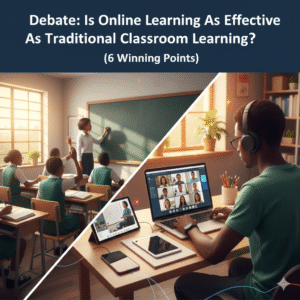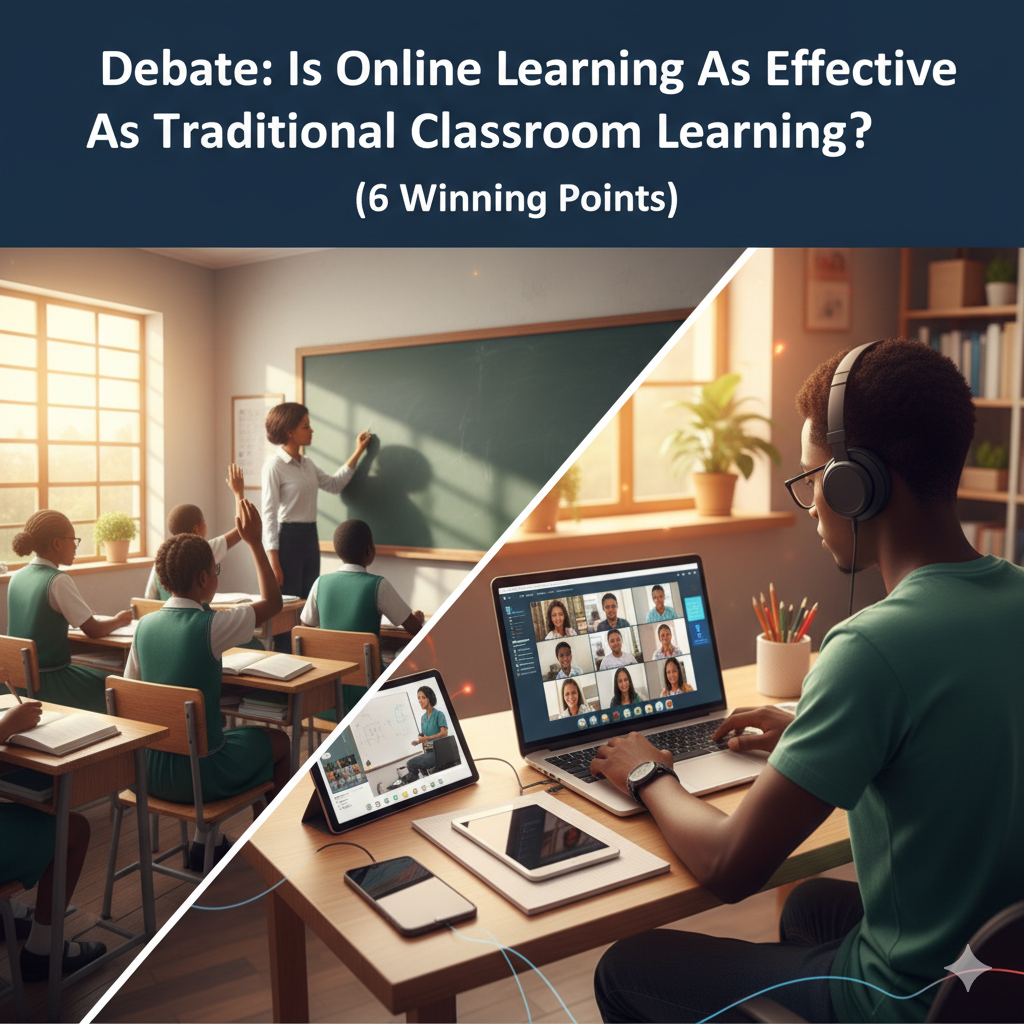Debate: Is online learning as effective as traditional classroom learning? (6 Winning Points)
Debate: Is online learning as effective as traditional classroom learning? (6 Winning Points)
Good day, debaters!
Looking for the winning points to support the motion that online learning is just as good, or even better, than the traditional classroom? You’ve come to the right place.
We are all here today to tackle a very important topic. The motion before us is: “Is online learning as effective as traditional classroom learning?”
As the main proponent of this motion, my answer is a clear and confident YES.
But first, let’s define our terms. “Traditional classroom learning” is the physical, face-to-face method we all know, with a teacher at the front of the hall. “Online learning” (or e-learning) uses the internet, computers, and digital tools to deliver lessons. This can be done anywhere, anytime.
The big question is, does this new method work? My opponents will say no. They will talk about the good old days. But I am here to argue that online learning is not just a replacement; in many ways, it’s an upgrade for the modern student.
Disclaimer: This article provides arguments for one side of an educational debate. The goal is to help students build a strong case, not to diminish the real and valid benefits of traditional classroom learning, which is also incredibly important.

Winning Debate Points on Why Online Learning is Just as Effective
1. Unmatched Flexibility and Accessibility
Honourable Judges, Panel of Timekeepers, my first point is simple: online learning breaks down barriers.
In a traditional system, you must be in one specific building, at one specific time. What if you are sick? What if you live too far away? What if the transport fare is too high that day? You miss the lesson. It’s gone.
Online learning solves this. It offers true flexibility. I can access my lessons from my home in Lagos, a cyber-café in Kaduna, or a village in Anambra, as long as I have an internet connection. This level of accessibility means that education is no longer a privilege for only those who can physically reach the school. It opens the door for everyone.
2. It Promotes Self-Paced and Personalized Learning
My second point is about the student. We all learn differently.
In a traditional class of 50 students, the teacher has one speed. If you are a fast learner, you get bored. If you are a slow learner, you get left behind. You are too shy to ask the teacher to repeat a point, so you just sit there, confused.
This is where online learning wins. It is a self-paced learning system. Did you miss what the lecturer said? Just rewind the video. Do you need more time on a topic? Pause and do your own research. You are in control. This is personalized learning. You fit the education to your brain, not the other way around.
Even global bodies agree. The [World Bank notes that technology can help] educators focus on personalized student learning, which is critical for success. You are no longer just a face in the crowd; you are an individual learner.
3. It Builds Critical Digital Literacy Skills for the Future
Now, let’s talk about the real world. My opponents are focused on passing exams. I am focused on building a future.
A traditional classroom teaches you academic subjects. An online classroom forces you to learn academic subjects and the technology of the 21st century. Think about it. To be a successful online student, you must learn to use computers, manage files, search for information, and communicate in virtual classrooms.
This is digital literacy. And in 2025, digital literacy is not optional. It is as important as reading and writing. These are the skills employers are begging for. A shocking [UNICEF Nigeria report highlights that many young people] in our country still lack these critical digital skills, which shows how vital it is that our education system builds them. Online learning does this automatically.
4. Online Learning is More Cost-Effective
My fourth point is one that every parent and student will understand: the cost.
Let’s be honest. “Free education” is not free. You pay for transport to and from school every single day. You pay for multiple, expensive textbooks. You pay for uniforms. You pay for hostel accommodation. These costs add up, and they can stop a brilliant student from continuing their education.
Online learning is far more cost-effective. There are no transport fares. There are no hostel fees. Digital textbooks are often cheaper or even free. This isn’t a small point; this is the difference between getting an education or getting left behind because of money.
5. It Teaches Real-World Time Management and Autonomy
The truth is, a traditional school can sometimes treat us like children. A bell tells you when to start, when to eat, and when to go home. You are managed.
Remote learning gives you a powerful responsibility. It gives you freedom, and that freedom teaches you discipline. This is called learner autonomy. You have to manage your schedule. You have to set deadlines. You have to motivate yourself to finish the work.
My opponents will call this a weakness. I call it the single most important strength. Online learning teaches time management and self-discipline better than any textbook. It treats you like an adult, and as a result, you learn to act like one.
6. Access to a Global Library of Information
Finally, my last point. In a physical classroom, your world is limited to the four walls of that room and the knowledge of one teacher.
With online learning, your classroom is the entire world.
You are not limited to the few books in your school library. You have access to the biggest libraries on earth. You are not limited to one teacher’s opinion. You can listen to lectures from professors at Harvard, watch tutorials from experts in India, and collaborate with students in other countries. The traditional classroom is a small pond; online learning is the entire ocean.
Frequently Asked Questions (FAQs)
Q: What is the strongest argument against online learning? A: The most common argument is the “lack of social interaction.” Opponents say you can’t make friends or talk to teachers. This is simply not true anymore. Modern online learning uses discussion forums, live virtual classrooms, and group chats where students and teachers interact all the time.
Q: Is online learning good for practical subjects like Chemistry or Physics? A: This is a fair question. For subjects that need a physical lab, a “hybrid” model (mixing online theory with some in-person practicals) is best. But for 90% of subjects—like Maths, English, Government, Economics, and all theory—online learning is just as effective, if not more so.
Q: How can I convince the judges that online learning isn’t just “lazy learning”? A: You use Point 5. Argue that it’s harder than traditional learning because it requires more self-discipline and time management. It’s not for lazy people; it’s for mature, motivated students.
Conclusion / Summary
So, Honourable Judges, let’s look at the facts.
The opposition wants to keep us in a system that is rigid, expensive, and limited to one room.
We are arguing for a future that is flexible, cost-effective, and builds the digital literacy skills we actually need. We are arguing for a personalized, self-paced system that gives every student in Nigeria, from the city to the village, a chance to access the world’s best knowledge.
When you weigh the evidence, the answer to the motion, “Is online learning as effective as traditional classroom learning?” is a resounding YES. It is not just effective; it is the future.
Final Disclaimer: Remember, both online and traditional education have immense value. The best solution is often a “hybrid” model that uses both. This article is simply a tool to help you argue one side of this motion for your school’s educational debate.
What do you think? Which side of the debate are you on? Drop your opinions in the comments section below… Also, feel free to share this post with your classmates or those in your debate team!








One Comment